British Airways: Reward Management, Motivation, and Strategy Report
VerifiedAdded on 2019/12/04
|10
|4081
|154
Report
AI Summary
This report provides a comprehensive analysis of reward management practices at British Airways (BA). It begins with an introduction to reward management, defining it as the strategic planning and execution of policies to ensure employees receive fair compensation aligned with their value to the company. The report examines BA's market position, pay mix, job value basis, reward focus, structure, and administration, highlighting the airline's approach to employee benefits, including travel concessions, pensions, and development opportunities. The report then explores the strategic approach to reward, discussing the strengths and weaknesses of different reward strategies, such as salary systems, short and long-term benefits, and benchmarking. It emphasizes the implementation of a chosen strategy and the importance of monitoring and evaluating its effectiveness. Task 2 delves into the process of motivation, considering both intrinsic and extrinsic motivators, with a focus on performance-related rewards. The report concludes by recommending strategies to mitigate future industrial actions by focusing on providing extrinsic rewards and benefit packages to motivate employees. The report also references EasyJet's reward systems for comparison and offers insights into the impact of reward practices on employee behavior and organizational performance.
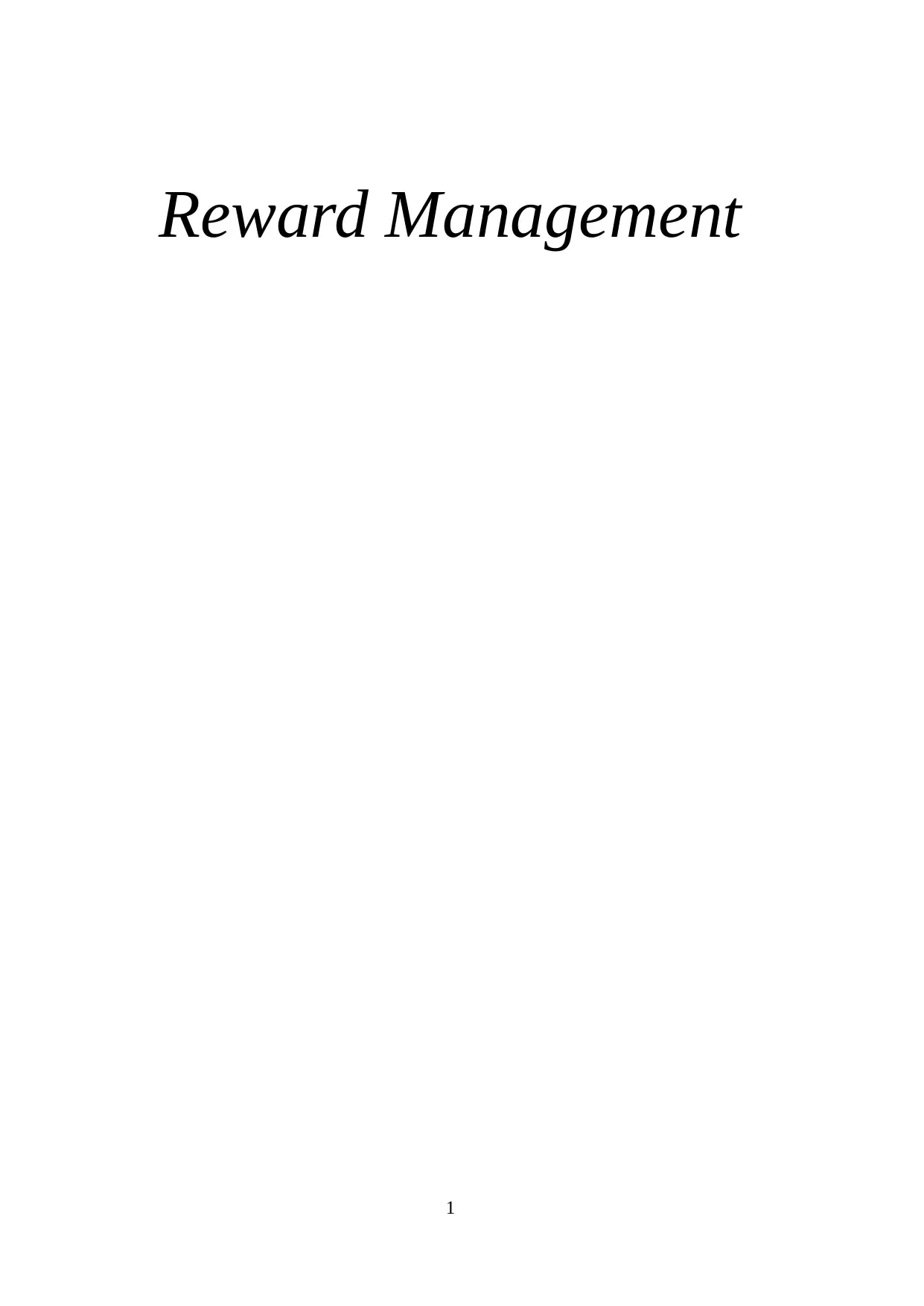
Reward Management
1
1
Paraphrase This Document
Need a fresh take? Get an instant paraphrase of this document with our AI Paraphraser
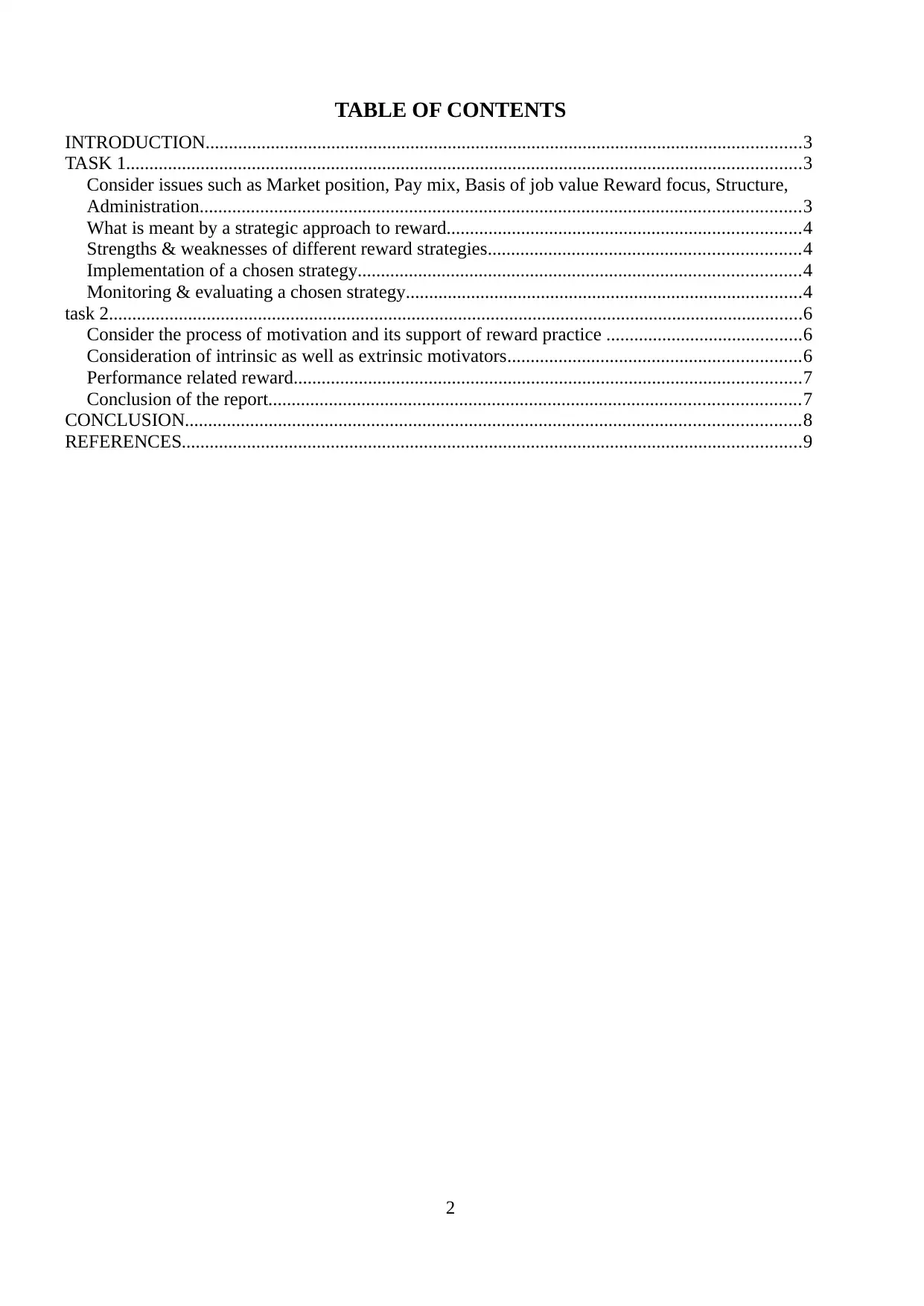
TABLE OF CONTENTS
INTRODUCTION................................................................................................................................3
TASK 1.................................................................................................................................................3
Consider issues such as Market position, Pay mix, Basis of job value Reward focus, Structure,
Administration.................................................................................................................................3
What is meant by a strategic approach to reward............................................................................4
Strengths & weaknesses of different reward strategies...................................................................4
Implementation of a chosen strategy...............................................................................................4
Monitoring & evaluating a chosen strategy.....................................................................................4
task 2.....................................................................................................................................................6
Consider the process of motivation and its support of reward practice ..........................................6
Consideration of intrinsic as well as extrinsic motivators...............................................................6
Performance related reward.............................................................................................................7
Conclusion of the report..................................................................................................................7
CONCLUSION....................................................................................................................................8
REFERENCES.....................................................................................................................................9
2
INTRODUCTION................................................................................................................................3
TASK 1.................................................................................................................................................3
Consider issues such as Market position, Pay mix, Basis of job value Reward focus, Structure,
Administration.................................................................................................................................3
What is meant by a strategic approach to reward............................................................................4
Strengths & weaknesses of different reward strategies...................................................................4
Implementation of a chosen strategy...............................................................................................4
Monitoring & evaluating a chosen strategy.....................................................................................4
task 2.....................................................................................................................................................6
Consider the process of motivation and its support of reward practice ..........................................6
Consideration of intrinsic as well as extrinsic motivators...............................................................6
Performance related reward.............................................................................................................7
Conclusion of the report..................................................................................................................7
CONCLUSION....................................................................................................................................8
REFERENCES.....................................................................................................................................9
2
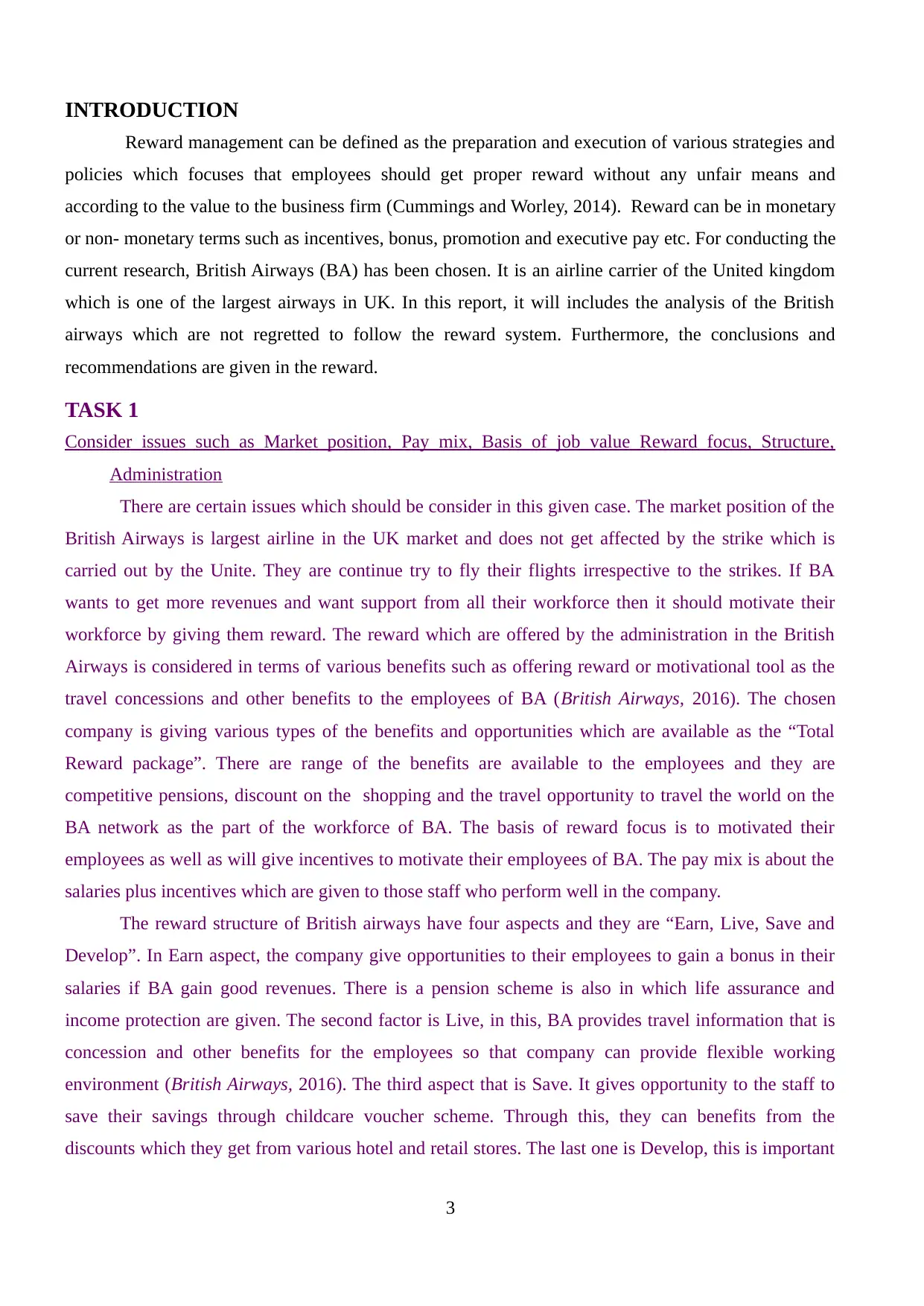
INTRODUCTION
Reward management can be defined as the preparation and execution of various strategies and
policies which focuses that employees should get proper reward without any unfair means and
according to the value to the business firm (Cummings and Worley, 2014). Reward can be in monetary
or non- monetary terms such as incentives, bonus, promotion and executive pay etc. For conducting the
current research, British Airways (BA) has been chosen. It is an airline carrier of the United kingdom
which is one of the largest airways in UK. In this report, it will includes the analysis of the British
airways which are not regretted to follow the reward system. Furthermore, the conclusions and
recommendations are given in the reward.
TASK 1
Consider issues such as Market position, Pay mix, Basis of job value Reward focus, Structure,
Administration
There are certain issues which should be consider in this given case. The market position of the
British Airways is largest airline in the UK market and does not get affected by the strike which is
carried out by the Unite. They are continue try to fly their flights irrespective to the strikes. If BA
wants to get more revenues and want support from all their workforce then it should motivate their
workforce by giving them reward. The reward which are offered by the administration in the British
Airways is considered in terms of various benefits such as offering reward or motivational tool as the
travel concessions and other benefits to the employees of BA (British Airways, 2016). The chosen
company is giving various types of the benefits and opportunities which are available as the “Total
Reward package”. There are range of the benefits are available to the employees and they are
competitive pensions, discount on the shopping and the travel opportunity to travel the world on the
BA network as the part of the workforce of BA. The basis of reward focus is to motivated their
employees as well as will give incentives to motivate their employees of BA. The pay mix is about the
salaries plus incentives which are given to those staff who perform well in the company.
The reward structure of British airways have four aspects and they are “Earn, Live, Save and
Develop”. In Earn aspect, the company give opportunities to their employees to gain a bonus in their
salaries if BA gain good revenues. There is a pension scheme is also in which life assurance and
income protection are given. The second factor is Live, in this, BA provides travel information that is
concession and other benefits for the employees so that company can provide flexible working
environment (British Airways, 2016). The third aspect that is Save. It gives opportunity to the staff to
save their savings through childcare voucher scheme. Through this, they can benefits from the
discounts which they get from various hotel and retail stores. The last one is Develop, this is important
3
Reward management can be defined as the preparation and execution of various strategies and
policies which focuses that employees should get proper reward without any unfair means and
according to the value to the business firm (Cummings and Worley, 2014). Reward can be in monetary
or non- monetary terms such as incentives, bonus, promotion and executive pay etc. For conducting the
current research, British Airways (BA) has been chosen. It is an airline carrier of the United kingdom
which is one of the largest airways in UK. In this report, it will includes the analysis of the British
airways which are not regretted to follow the reward system. Furthermore, the conclusions and
recommendations are given in the reward.
TASK 1
Consider issues such as Market position, Pay mix, Basis of job value Reward focus, Structure,
Administration
There are certain issues which should be consider in this given case. The market position of the
British Airways is largest airline in the UK market and does not get affected by the strike which is
carried out by the Unite. They are continue try to fly their flights irrespective to the strikes. If BA
wants to get more revenues and want support from all their workforce then it should motivate their
workforce by giving them reward. The reward which are offered by the administration in the British
Airways is considered in terms of various benefits such as offering reward or motivational tool as the
travel concessions and other benefits to the employees of BA (British Airways, 2016). The chosen
company is giving various types of the benefits and opportunities which are available as the “Total
Reward package”. There are range of the benefits are available to the employees and they are
competitive pensions, discount on the shopping and the travel opportunity to travel the world on the
BA network as the part of the workforce of BA. The basis of reward focus is to motivated their
employees as well as will give incentives to motivate their employees of BA. The pay mix is about the
salaries plus incentives which are given to those staff who perform well in the company.
The reward structure of British airways have four aspects and they are “Earn, Live, Save and
Develop”. In Earn aspect, the company give opportunities to their employees to gain a bonus in their
salaries if BA gain good revenues. There is a pension scheme is also in which life assurance and
income protection are given. The second factor is Live, in this, BA provides travel information that is
concession and other benefits for the employees so that company can provide flexible working
environment (British Airways, 2016). The third aspect that is Save. It gives opportunity to the staff to
save their savings through childcare voucher scheme. Through this, they can benefits from the
discounts which they get from various hotel and retail stores. The last one is Develop, this is important
3
⊘ This is a preview!⊘
Do you want full access?
Subscribe today to unlock all pages.

Trusted by 1+ million students worldwide
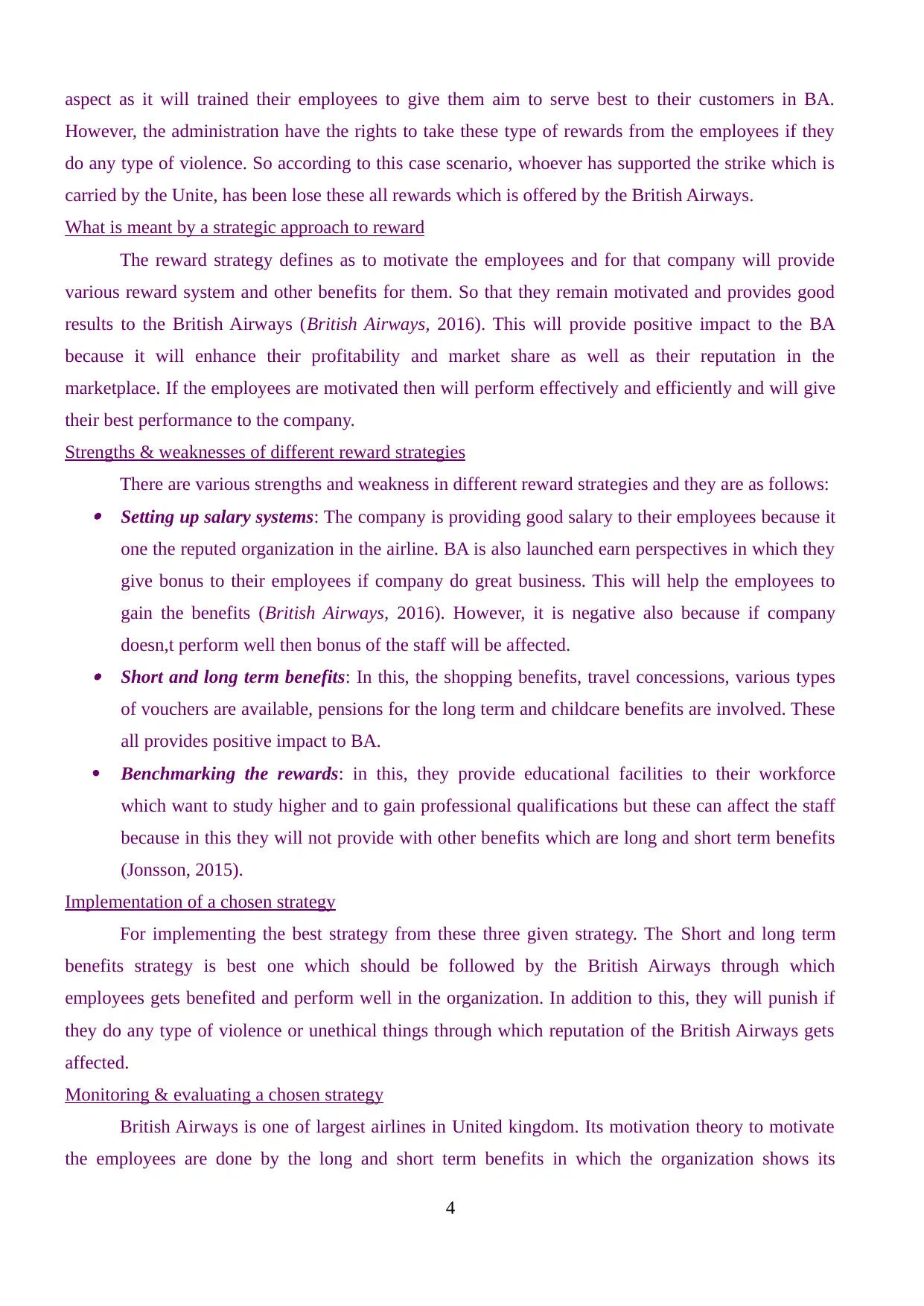
aspect as it will trained their employees to give them aim to serve best to their customers in BA.
However, the administration have the rights to take these type of rewards from the employees if they
do any type of violence. So according to this case scenario, whoever has supported the strike which is
carried by the Unite, has been lose these all rewards which is offered by the British Airways.
What is meant by a strategic approach to reward
The reward strategy defines as to motivate the employees and for that company will provide
various reward system and other benefits for them. So that they remain motivated and provides good
results to the British Airways (British Airways, 2016). This will provide positive impact to the BA
because it will enhance their profitability and market share as well as their reputation in the
marketplace. If the employees are motivated then will perform effectively and efficiently and will give
their best performance to the company.
Strengths & weaknesses of different reward strategies
There are various strengths and weakness in different reward strategies and they are as follows: Setting up salary systems: The company is providing good salary to their employees because it
one the reputed organization in the airline. BA is also launched earn perspectives in which they
give bonus to their employees if company do great business. This will help the employees to
gain the benefits (British Airways, 2016). However, it is negative also because if company
doesn,t perform well then bonus of the staff will be affected. Short and long term benefits: In this, the shopping benefits, travel concessions, various types
of vouchers are available, pensions for the long term and childcare benefits are involved. These
all provides positive impact to BA.
Benchmarking the rewards: in this, they provide educational facilities to their workforce
which want to study higher and to gain professional qualifications but these can affect the staff
because in this they will not provide with other benefits which are long and short term benefits
(Jonsson, 2015).
Implementation of a chosen strategy
For implementing the best strategy from these three given strategy. The Short and long term
benefits strategy is best one which should be followed by the British Airways through which
employees gets benefited and perform well in the organization. In addition to this, they will punish if
they do any type of violence or unethical things through which reputation of the British Airways gets
affected.
Monitoring & evaluating a chosen strategy
British Airways is one of largest airlines in United kingdom. Its motivation theory to motivate
the employees are done by the long and short term benefits in which the organization shows its
4
However, the administration have the rights to take these type of rewards from the employees if they
do any type of violence. So according to this case scenario, whoever has supported the strike which is
carried by the Unite, has been lose these all rewards which is offered by the British Airways.
What is meant by a strategic approach to reward
The reward strategy defines as to motivate the employees and for that company will provide
various reward system and other benefits for them. So that they remain motivated and provides good
results to the British Airways (British Airways, 2016). This will provide positive impact to the BA
because it will enhance their profitability and market share as well as their reputation in the
marketplace. If the employees are motivated then will perform effectively and efficiently and will give
their best performance to the company.
Strengths & weaknesses of different reward strategies
There are various strengths and weakness in different reward strategies and they are as follows: Setting up salary systems: The company is providing good salary to their employees because it
one the reputed organization in the airline. BA is also launched earn perspectives in which they
give bonus to their employees if company do great business. This will help the employees to
gain the benefits (British Airways, 2016). However, it is negative also because if company
doesn,t perform well then bonus of the staff will be affected. Short and long term benefits: In this, the shopping benefits, travel concessions, various types
of vouchers are available, pensions for the long term and childcare benefits are involved. These
all provides positive impact to BA.
Benchmarking the rewards: in this, they provide educational facilities to their workforce
which want to study higher and to gain professional qualifications but these can affect the staff
because in this they will not provide with other benefits which are long and short term benefits
(Jonsson, 2015).
Implementation of a chosen strategy
For implementing the best strategy from these three given strategy. The Short and long term
benefits strategy is best one which should be followed by the British Airways through which
employees gets benefited and perform well in the organization. In addition to this, they will punish if
they do any type of violence or unethical things through which reputation of the British Airways gets
affected.
Monitoring & evaluating a chosen strategy
British Airways is one of largest airlines in United kingdom. Its motivation theory to motivate
the employees are done by the long and short term benefits in which the organization shows its
4
Paraphrase This Document
Need a fresh take? Get an instant paraphrase of this document with our AI Paraphraser
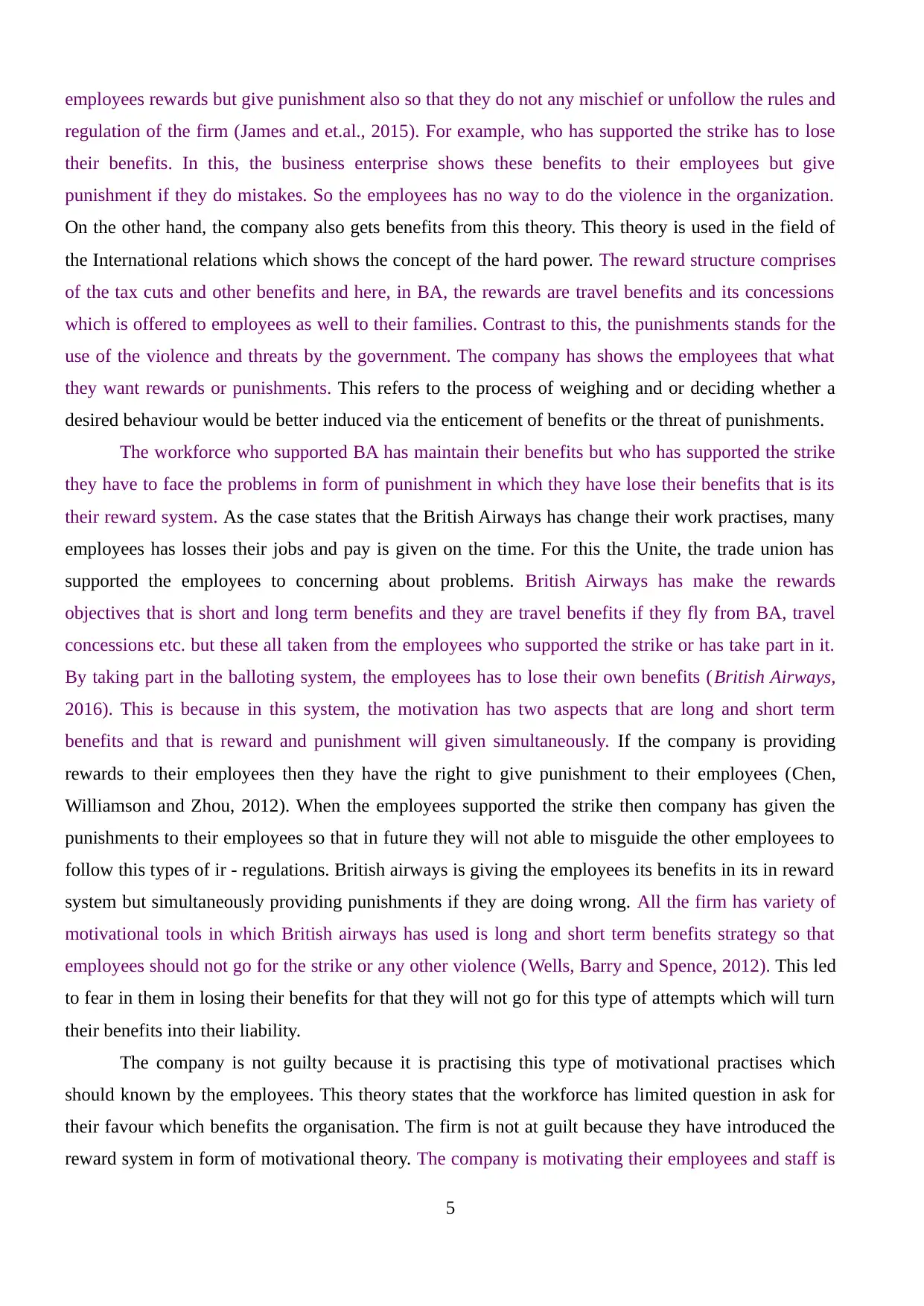
employees rewards but give punishment also so that they do not any mischief or unfollow the rules and
regulation of the firm (James and et.al., 2015). For example, who has supported the strike has to lose
their benefits. In this, the business enterprise shows these benefits to their employees but give
punishment if they do mistakes. So the employees has no way to do the violence in the organization.
On the other hand, the company also gets benefits from this theory. This theory is used in the field of
the International relations which shows the concept of the hard power. The reward structure comprises
of the tax cuts and other benefits and here, in BA, the rewards are travel benefits and its concessions
which is offered to employees as well to their families. Contrast to this, the punishments stands for the
use of the violence and threats by the government. The company has shows the employees that what
they want rewards or punishments. This refers to the process of weighing and or deciding whether a
desired behaviour would be better induced via the enticement of benefits or the threat of punishments.
The workforce who supported BA has maintain their benefits but who has supported the strike
they have to face the problems in form of punishment in which they have lose their benefits that is its
their reward system. As the case states that the British Airways has change their work practises, many
employees has losses their jobs and pay is given on the time. For this the Unite, the trade union has
supported the employees to concerning about problems. British Airways has make the rewards
objectives that is short and long term benefits and they are travel benefits if they fly from BA, travel
concessions etc. but these all taken from the employees who supported the strike or has take part in it.
By taking part in the balloting system, the employees has to lose their own benefits (British Airways,
2016). This is because in this system, the motivation has two aspects that are long and short term
benefits and that is reward and punishment will given simultaneously. If the company is providing
rewards to their employees then they have the right to give punishment to their employees (Chen,
Williamson and Zhou, 2012). When the employees supported the strike then company has given the
punishments to their employees so that in future they will not able to misguide the other employees to
follow this types of ir - regulations. British airways is giving the employees its benefits in its in reward
system but simultaneously providing punishments if they are doing wrong. All the firm has variety of
motivational tools in which British airways has used is long and short term benefits strategy so that
employees should not go for the strike or any other violence (Wells, Barry and Spence, 2012). This led
to fear in them in losing their benefits for that they will not go for this type of attempts which will turn
their benefits into their liability.
The company is not guilty because it is practising this type of motivational practises which
should known by the employees. This theory states that the workforce has limited question in ask for
their favour which benefits the organisation. The firm is not at guilt because they have introduced the
reward system in form of motivational theory. The company is motivating their employees and staff is
5
regulation of the firm (James and et.al., 2015). For example, who has supported the strike has to lose
their benefits. In this, the business enterprise shows these benefits to their employees but give
punishment if they do mistakes. So the employees has no way to do the violence in the organization.
On the other hand, the company also gets benefits from this theory. This theory is used in the field of
the International relations which shows the concept of the hard power. The reward structure comprises
of the tax cuts and other benefits and here, in BA, the rewards are travel benefits and its concessions
which is offered to employees as well to their families. Contrast to this, the punishments stands for the
use of the violence and threats by the government. The company has shows the employees that what
they want rewards or punishments. This refers to the process of weighing and or deciding whether a
desired behaviour would be better induced via the enticement of benefits or the threat of punishments.
The workforce who supported BA has maintain their benefits but who has supported the strike
they have to face the problems in form of punishment in which they have lose their benefits that is its
their reward system. As the case states that the British Airways has change their work practises, many
employees has losses their jobs and pay is given on the time. For this the Unite, the trade union has
supported the employees to concerning about problems. British Airways has make the rewards
objectives that is short and long term benefits and they are travel benefits if they fly from BA, travel
concessions etc. but these all taken from the employees who supported the strike or has take part in it.
By taking part in the balloting system, the employees has to lose their own benefits (British Airways,
2016). This is because in this system, the motivation has two aspects that are long and short term
benefits and that is reward and punishment will given simultaneously. If the company is providing
rewards to their employees then they have the right to give punishment to their employees (Chen,
Williamson and Zhou, 2012). When the employees supported the strike then company has given the
punishments to their employees so that in future they will not able to misguide the other employees to
follow this types of ir - regulations. British airways is giving the employees its benefits in its in reward
system but simultaneously providing punishments if they are doing wrong. All the firm has variety of
motivational tools in which British airways has used is long and short term benefits strategy so that
employees should not go for the strike or any other violence (Wells, Barry and Spence, 2012). This led
to fear in them in losing their benefits for that they will not go for this type of attempts which will turn
their benefits into their liability.
The company is not guilty because it is practising this type of motivational practises which
should known by the employees. This theory states that the workforce has limited question in ask for
their favour which benefits the organisation. The firm is not at guilt because they have introduced the
reward system in form of motivational theory. The company is motivating their employees and staff is
5
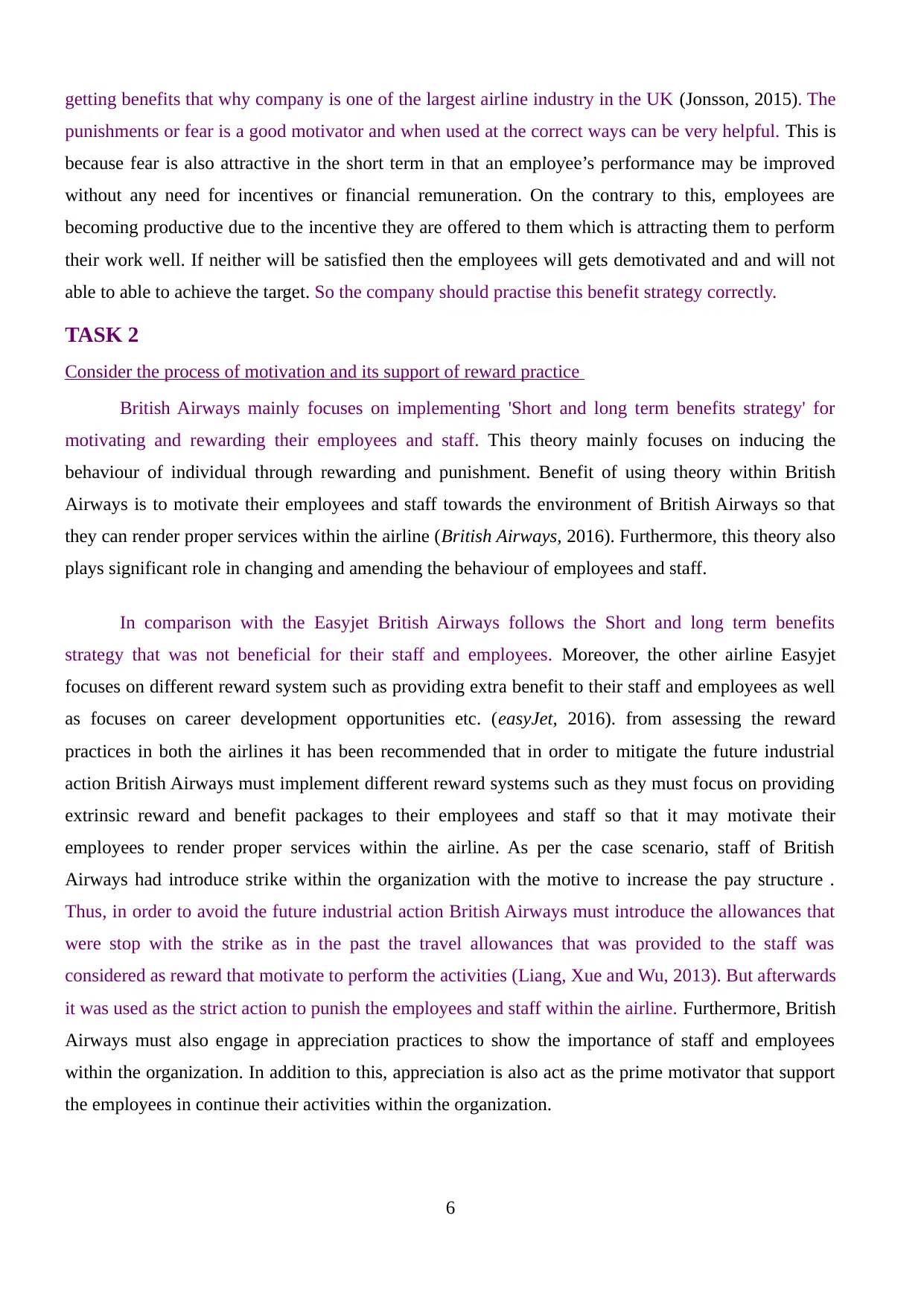
getting benefits that why company is one of the largest airline industry in the UK (Jonsson, 2015). The
punishments or fear is a good motivator and when used at the correct ways can be very helpful. This is
because fear is also attractive in the short term in that an employee’s performance may be improved
without any need for incentives or financial remuneration. On the contrary to this, employees are
becoming productive due to the incentive they are offered to them which is attracting them to perform
their work well. If neither will be satisfied then the employees will gets demotivated and and will not
able to able to achieve the target. So the company should practise this benefit strategy correctly.
TASK 2
Consider the process of motivation and its support of reward practice
British Airways mainly focuses on implementing 'Short and long term benefits strategy' for
motivating and rewarding their employees and staff. This theory mainly focuses on inducing the
behaviour of individual through rewarding and punishment. Benefit of using theory within British
Airways is to motivate their employees and staff towards the environment of British Airways so that
they can render proper services within the airline (British Airways, 2016). Furthermore, this theory also
plays significant role in changing and amending the behaviour of employees and staff.
In comparison with the Easyjet British Airways follows the Short and long term benefits
strategy that was not beneficial for their staff and employees. Moreover, the other airline Easyjet
focuses on different reward system such as providing extra benefit to their staff and employees as well
as focuses on career development opportunities etc. (easyJet, 2016). from assessing the reward
practices in both the airlines it has been recommended that in order to mitigate the future industrial
action British Airways must implement different reward systems such as they must focus on providing
extrinsic reward and benefit packages to their employees and staff so that it may motivate their
employees to render proper services within the airline. As per the case scenario, staff of British
Airways had introduce strike within the organization with the motive to increase the pay structure .
Thus, in order to avoid the future industrial action British Airways must introduce the allowances that
were stop with the strike as in the past the travel allowances that was provided to the staff was
considered as reward that motivate to perform the activities (Liang, Xue and Wu, 2013). But afterwards
it was used as the strict action to punish the employees and staff within the airline. Furthermore, British
Airways must also engage in appreciation practices to show the importance of staff and employees
within the organization. In addition to this, appreciation is also act as the prime motivator that support
the employees in continue their activities within the organization.
6
punishments or fear is a good motivator and when used at the correct ways can be very helpful. This is
because fear is also attractive in the short term in that an employee’s performance may be improved
without any need for incentives or financial remuneration. On the contrary to this, employees are
becoming productive due to the incentive they are offered to them which is attracting them to perform
their work well. If neither will be satisfied then the employees will gets demotivated and and will not
able to able to achieve the target. So the company should practise this benefit strategy correctly.
TASK 2
Consider the process of motivation and its support of reward practice
British Airways mainly focuses on implementing 'Short and long term benefits strategy' for
motivating and rewarding their employees and staff. This theory mainly focuses on inducing the
behaviour of individual through rewarding and punishment. Benefit of using theory within British
Airways is to motivate their employees and staff towards the environment of British Airways so that
they can render proper services within the airline (British Airways, 2016). Furthermore, this theory also
plays significant role in changing and amending the behaviour of employees and staff.
In comparison with the Easyjet British Airways follows the Short and long term benefits
strategy that was not beneficial for their staff and employees. Moreover, the other airline Easyjet
focuses on different reward system such as providing extra benefit to their staff and employees as well
as focuses on career development opportunities etc. (easyJet, 2016). from assessing the reward
practices in both the airlines it has been recommended that in order to mitigate the future industrial
action British Airways must implement different reward systems such as they must focus on providing
extrinsic reward and benefit packages to their employees and staff so that it may motivate their
employees to render proper services within the airline. As per the case scenario, staff of British
Airways had introduce strike within the organization with the motive to increase the pay structure .
Thus, in order to avoid the future industrial action British Airways must introduce the allowances that
were stop with the strike as in the past the travel allowances that was provided to the staff was
considered as reward that motivate to perform the activities (Liang, Xue and Wu, 2013). But afterwards
it was used as the strict action to punish the employees and staff within the airline. Furthermore, British
Airways must also engage in appreciation practices to show the importance of staff and employees
within the organization. In addition to this, appreciation is also act as the prime motivator that support
the employees in continue their activities within the organization.
6
⊘ This is a preview!⊘
Do you want full access?
Subscribe today to unlock all pages.

Trusted by 1+ million students worldwide
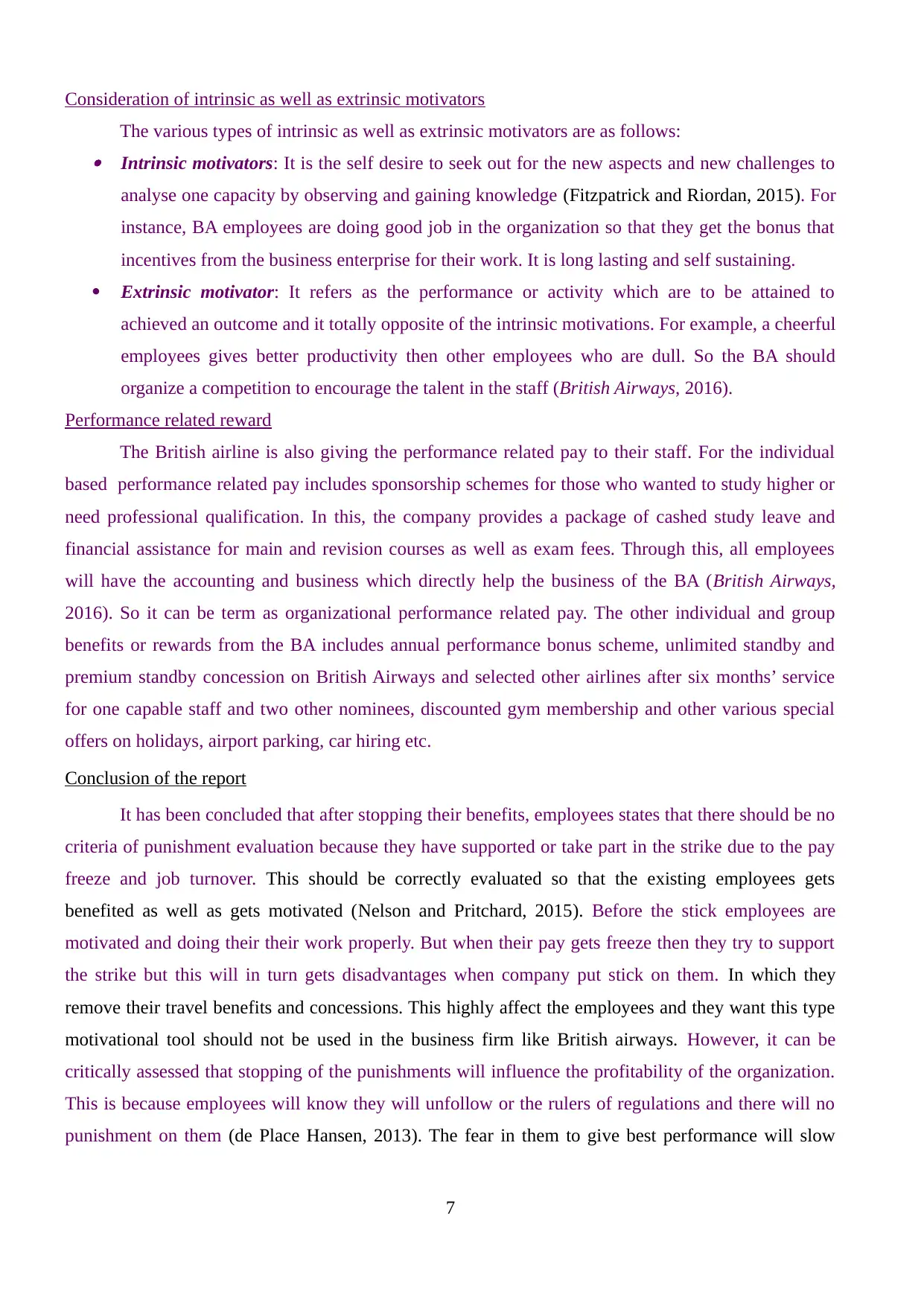
Consideration of intrinsic as well as extrinsic motivators
The various types of intrinsic as well as extrinsic motivators are as follows: Intrinsic motivators: It is the self desire to seek out for the new aspects and new challenges to
analyse one capacity by observing and gaining knowledge (Fitzpatrick and Riordan, 2015). For
instance, BA employees are doing good job in the organization so that they get the bonus that
incentives from the business enterprise for their work. It is long lasting and self sustaining.
Extrinsic motivator: It refers as the performance or activity which are to be attained to
achieved an outcome and it totally opposite of the intrinsic motivations. For example, a cheerful
employees gives better productivity then other employees who are dull. So the BA should
organize a competition to encourage the talent in the staff (British Airways, 2016).
Performance related reward
The British airline is also giving the performance related pay to their staff. For the individual
based performance related pay includes sponsorship schemes for those who wanted to study higher or
need professional qualification. In this, the company provides a package of cashed study leave and
financial assistance for main and revision courses as well as exam fees. Through this, all employees
will have the accounting and business which directly help the business of the BA (British Airways,
2016). So it can be term as organizational performance related pay. The other individual and group
benefits or rewards from the BA includes annual performance bonus scheme, unlimited standby and
premium standby concession on British Airways and selected other airlines after six months’ service
for one capable staff and two other nominees, discounted gym membership and other various special
offers on holidays, airport parking, car hiring etc.
Conclusion of the report
It has been concluded that after stopping their benefits, employees states that there should be no
criteria of punishment evaluation because they have supported or take part in the strike due to the pay
freeze and job turnover. This should be correctly evaluated so that the existing employees gets
benefited as well as gets motivated (Nelson and Pritchard, 2015). Before the stick employees are
motivated and doing their their work properly. But when their pay gets freeze then they try to support
the strike but this will in turn gets disadvantages when company put stick on them. In which they
remove their travel benefits and concessions. This highly affect the employees and they want this type
motivational tool should not be used in the business firm like British airways. However, it can be
critically assessed that stopping of the punishments will influence the profitability of the organization.
This is because employees will know they will unfollow or the rulers of regulations and there will no
punishment on them (de Place Hansen, 2013). The fear in them to give best performance will slow
7
The various types of intrinsic as well as extrinsic motivators are as follows: Intrinsic motivators: It is the self desire to seek out for the new aspects and new challenges to
analyse one capacity by observing and gaining knowledge (Fitzpatrick and Riordan, 2015). For
instance, BA employees are doing good job in the organization so that they get the bonus that
incentives from the business enterprise for their work. It is long lasting and self sustaining.
Extrinsic motivator: It refers as the performance or activity which are to be attained to
achieved an outcome and it totally opposite of the intrinsic motivations. For example, a cheerful
employees gives better productivity then other employees who are dull. So the BA should
organize a competition to encourage the talent in the staff (British Airways, 2016).
Performance related reward
The British airline is also giving the performance related pay to their staff. For the individual
based performance related pay includes sponsorship schemes for those who wanted to study higher or
need professional qualification. In this, the company provides a package of cashed study leave and
financial assistance for main and revision courses as well as exam fees. Through this, all employees
will have the accounting and business which directly help the business of the BA (British Airways,
2016). So it can be term as organizational performance related pay. The other individual and group
benefits or rewards from the BA includes annual performance bonus scheme, unlimited standby and
premium standby concession on British Airways and selected other airlines after six months’ service
for one capable staff and two other nominees, discounted gym membership and other various special
offers on holidays, airport parking, car hiring etc.
Conclusion of the report
It has been concluded that after stopping their benefits, employees states that there should be no
criteria of punishment evaluation because they have supported or take part in the strike due to the pay
freeze and job turnover. This should be correctly evaluated so that the existing employees gets
benefited as well as gets motivated (Nelson and Pritchard, 2015). Before the stick employees are
motivated and doing their their work properly. But when their pay gets freeze then they try to support
the strike but this will in turn gets disadvantages when company put stick on them. In which they
remove their travel benefits and concessions. This highly affect the employees and they want this type
motivational tool should not be used in the business firm like British airways. However, it can be
critically assessed that stopping of the punishments will influence the profitability of the organization.
This is because employees will know they will unfollow or the rulers of regulations and there will no
punishment on them (de Place Hansen, 2013). The fear in them to give best performance will slow
7
Paraphrase This Document
Need a fresh take? Get an instant paraphrase of this document with our AI Paraphraser
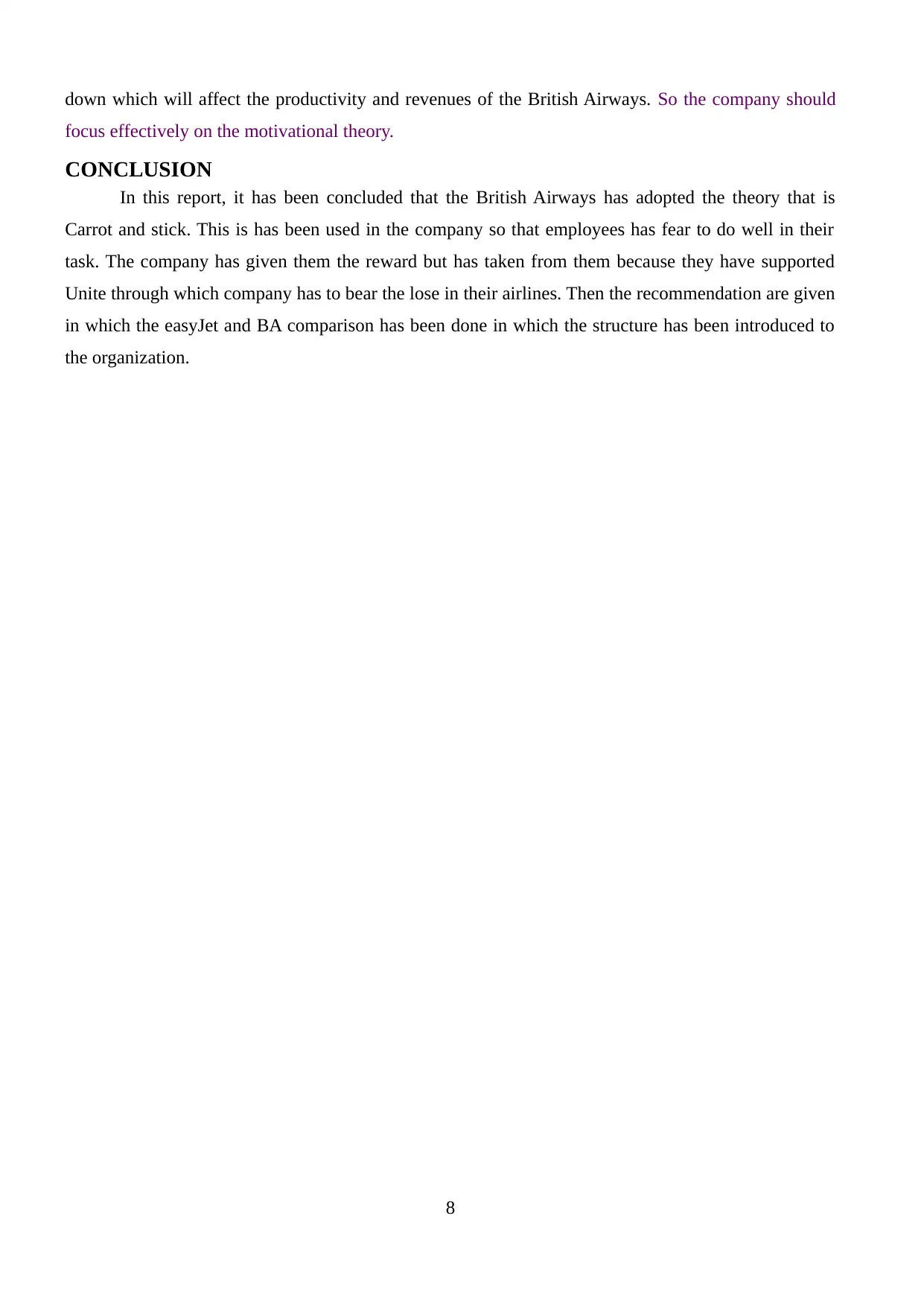
down which will affect the productivity and revenues of the British Airways. So the company should
focus effectively on the motivational theory.
CONCLUSION
In this report, it has been concluded that the British Airways has adopted the theory that is
Carrot and stick. This is has been used in the company so that employees has fear to do well in their
task. The company has given them the reward but has taken from them because they have supported
Unite through which company has to bear the lose in their airlines. Then the recommendation are given
in which the easyJet and BA comparison has been done in which the structure has been introduced to
the organization.
8
focus effectively on the motivational theory.
CONCLUSION
In this report, it has been concluded that the British Airways has adopted the theory that is
Carrot and stick. This is has been used in the company so that employees has fear to do well in their
task. The company has given them the reward but has taken from them because they have supported
Unite through which company has to bear the lose in their airlines. Then the recommendation are given
in which the easyJet and BA comparison has been done in which the structure has been introduced to
the organization.
8
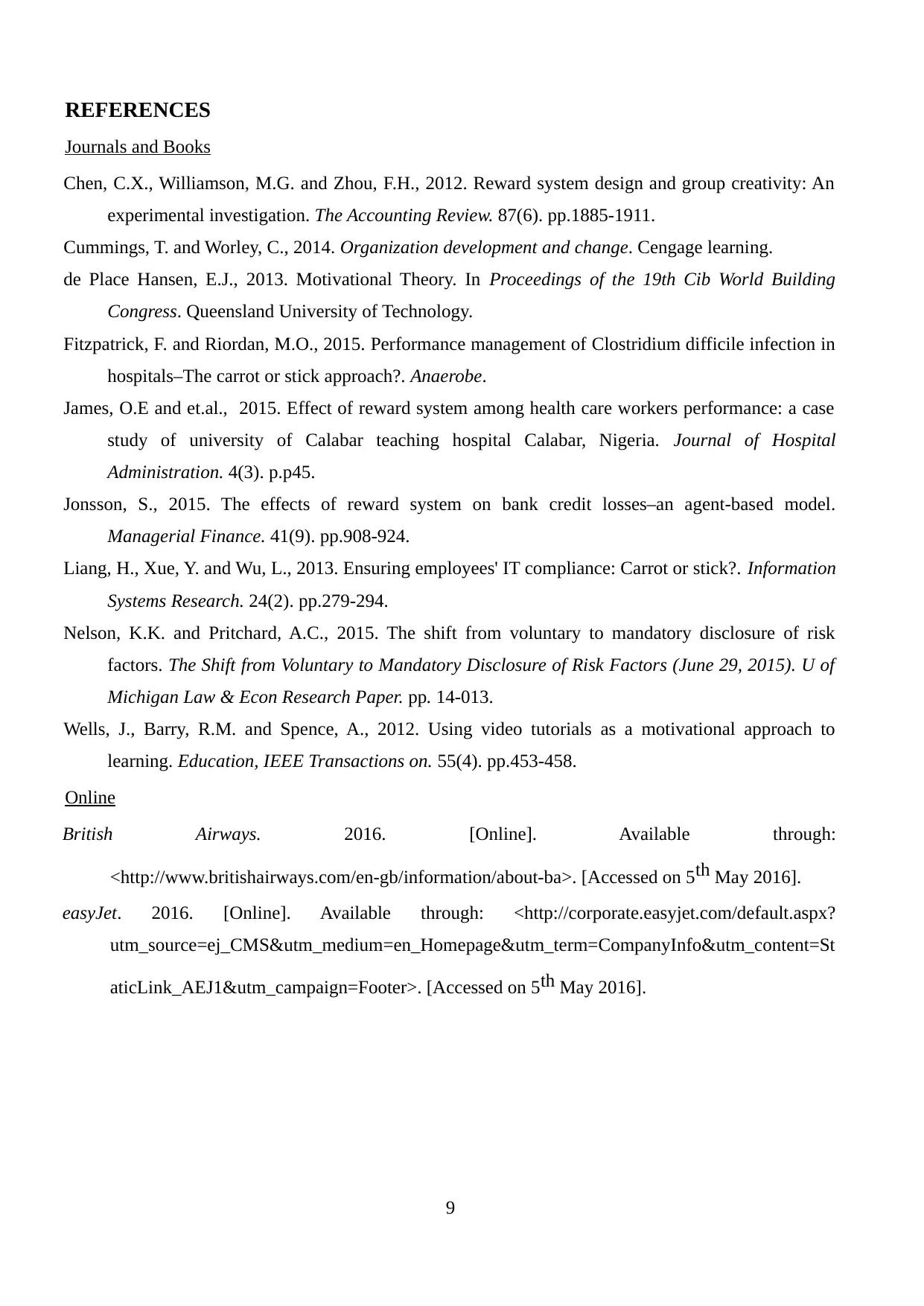
REFERENCES
Journals and Books
Chen, C.X., Williamson, M.G. and Zhou, F.H., 2012. Reward system design and group creativity: An
experimental investigation. The Accounting Review. 87(6). pp.1885-1911.
Cummings, T. and Worley, C., 2014. Organization development and change. Cengage learning.
de Place Hansen, E.J., 2013. Motivational Theory. In Proceedings of the 19th Cib World Building
Congress. Queensland University of Technology.
Fitzpatrick, F. and Riordan, M.O., 2015. Performance management of Clostridium difficile infection in
hospitals–The carrot or stick approach?. Anaerobe.
James, O.E and et.al., 2015. Effect of reward system among health care workers performance: a case
study of university of Calabar teaching hospital Calabar, Nigeria. Journal of Hospital
Administration. 4(3). p.p45.
Jonsson, S., 2015. The effects of reward system on bank credit losses–an agent-based model.
Managerial Finance. 41(9). pp.908-924.
Liang, H., Xue, Y. and Wu, L., 2013. Ensuring employees' IT compliance: Carrot or stick?. Information
Systems Research. 24(2). pp.279-294.
Nelson, K.K. and Pritchard, A.C., 2015. The shift from voluntary to mandatory disclosure of risk
factors. The Shift from Voluntary to Mandatory Disclosure of Risk Factors (June 29, 2015). U of
Michigan Law & Econ Research Paper. pp. 14-013.
Wells, J., Barry, R.M. and Spence, A., 2012. Using video tutorials as a motivational approach to
learning. Education, IEEE Transactions on. 55(4). pp.453-458.
Online
British Airways. 2016. [Online]. Available through:
<http://www.britishairways.com/en-gb/information/about-ba>. [Accessed on 5th May 2016].
easyJet. 2016. [Online]. Available through: <http://corporate.easyjet.com/default.aspx?
utm_source=ej_CMS&utm_medium=en_Homepage&utm_term=CompanyInfo&utm_content=St
aticLink_AEJ1&utm_campaign=Footer>. [Accessed on 5th May 2016].
9
Journals and Books
Chen, C.X., Williamson, M.G. and Zhou, F.H., 2012. Reward system design and group creativity: An
experimental investigation. The Accounting Review. 87(6). pp.1885-1911.
Cummings, T. and Worley, C., 2014. Organization development and change. Cengage learning.
de Place Hansen, E.J., 2013. Motivational Theory. In Proceedings of the 19th Cib World Building
Congress. Queensland University of Technology.
Fitzpatrick, F. and Riordan, M.O., 2015. Performance management of Clostridium difficile infection in
hospitals–The carrot or stick approach?. Anaerobe.
James, O.E and et.al., 2015. Effect of reward system among health care workers performance: a case
study of university of Calabar teaching hospital Calabar, Nigeria. Journal of Hospital
Administration. 4(3). p.p45.
Jonsson, S., 2015. The effects of reward system on bank credit losses–an agent-based model.
Managerial Finance. 41(9). pp.908-924.
Liang, H., Xue, Y. and Wu, L., 2013. Ensuring employees' IT compliance: Carrot or stick?. Information
Systems Research. 24(2). pp.279-294.
Nelson, K.K. and Pritchard, A.C., 2015. The shift from voluntary to mandatory disclosure of risk
factors. The Shift from Voluntary to Mandatory Disclosure of Risk Factors (June 29, 2015). U of
Michigan Law & Econ Research Paper. pp. 14-013.
Wells, J., Barry, R.M. and Spence, A., 2012. Using video tutorials as a motivational approach to
learning. Education, IEEE Transactions on. 55(4). pp.453-458.
Online
British Airways. 2016. [Online]. Available through:
<http://www.britishairways.com/en-gb/information/about-ba>. [Accessed on 5th May 2016].
easyJet. 2016. [Online]. Available through: <http://corporate.easyjet.com/default.aspx?
utm_source=ej_CMS&utm_medium=en_Homepage&utm_term=CompanyInfo&utm_content=St
aticLink_AEJ1&utm_campaign=Footer>. [Accessed on 5th May 2016].
9
⊘ This is a preview!⊘
Do you want full access?
Subscribe today to unlock all pages.

Trusted by 1+ million students worldwide

Page | 10
1 out of 10
Related Documents
Your All-in-One AI-Powered Toolkit for Academic Success.
+13062052269
info@desklib.com
Available 24*7 on WhatsApp / Email
![[object Object]](/_next/static/media/star-bottom.7253800d.svg)
Unlock your academic potential
Copyright © 2020–2025 A2Z Services. All Rights Reserved. Developed and managed by ZUCOL.




